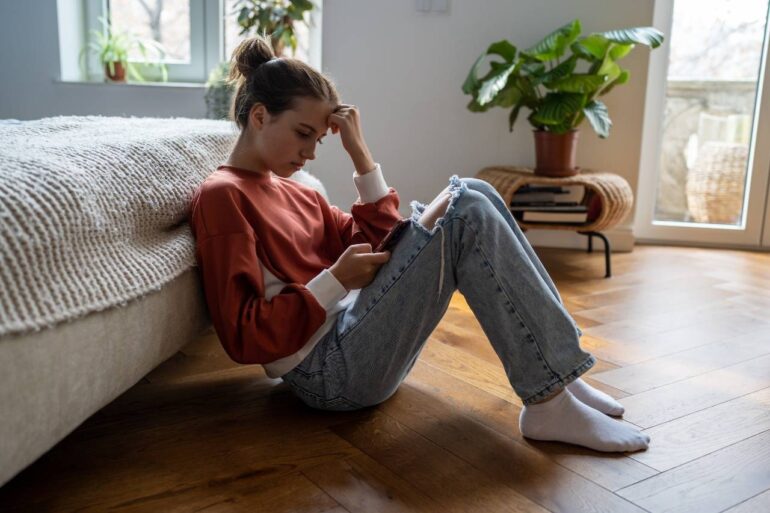

Paradoxically, the mental health services of the Spanish health system are underused, warns this review, which attributes this to users’ problems in accessing them.
Among all mental illnesses, disorders of anxiety They are the most frequent, in their different variants: panic disorder, generalized, social or separation anxiety, without forgetting specific phobias (fear of animals, of traveling by plane, of injections, etc.).
Anxiety has accompanied humanity throughout its history as a driver of change and survival, but when it appears disproportionately or in the face of erroneous stimuli, it is called an anxiety disorder, according to experts.
Last August the Annual Mental Health Report 2023 of the Ministry of Health where it is pointed out that anxiety disorders affect the 10% of the populationtwice as many women (14%) as men (7%). They are the most common mental health problems in those under 25 years of age (3 out of every 100 have them), especially in childhood and adolescence. Specialists have focused their attention on this group in recent years.
Mental health problem in the youngest
Many barometers collect the minor discomfort. The last one was presented a few days ago by UNICEF Spain and the University of Seville, according to this Opinion barometer on mental health of children and adolescents 2023-2024based on 5,000 teenagers between 12 and 18 years old from 168 educational centers, four out of every 10 adolescents “state that they have had or believe they have had” a mental health problem in the last twelve months.
Hospitalizations for this reason have even increased in Spain, as reported in a recent study by researchers from the International University of La Rioja. Its authors warn of the “pernicious influence” that new online technologies and internet applications, such as social networks and video gamesexert on the neurological and psychological development of children and young people.
For their part, and on the occasion of Pediatrics Day 2024 this October 8, the pediatricians have also raised the alarm about what they describe as “one of the biggest health challenges of our time: child and adolescent mental health”, as it is a vulnerable stage in which more than 70% of the mental health problems that persist throughout adulthood are forged.
Social networks worsen previous symptoms
The president of the Society of Child Psychiatry, Pedro Javier Rodríguez Hernándezin his triple role as pediatrician, child and adolescent psychiatrist and psychologist, highlights that anxiety disorder, phobias and obsessive-compulsive disorder (OCD) They appear more intensely and occur in younger children each time. And social media has come to exacerbate the symptoms of those who already had an anxious base.
The first to see and treat children and adolescents are pediatricians, who are in charge of managing the mildest cases, giving them guidelines for managing symptomsalong with relaxation exercises. And in other cases, pharmacological treatments are resorted to with “some very mild tranquilizer“, Rodríguez clarifies to SINC.
However, many parents go to the doctor’s office psychologistswho have also noted the increase in anxiety disorders. From the Álava Reyes Psychology Center, with more than 30 years of experience, the director of the children and youth area, Silvia Alavacorroborates it.
As he explains to SINC, “some adolescents even come with a self-diagnosis of anxiety or depression because they have seen a video on social networks. Another thing is that it is really proven that there is a disorder. But what is especially problematic is that adolescents and children are telling us that they are not well, regardless of whether they later fail to meet the diagnostic criteria.”

Unlike primary care, where time is scarce due to work overload, in psychology centers the problem is addressed with more time and continuity. “These disorders have a lot to do with socio-emotional skills”says the expert.
Frenetic pace since childhood
The function of the psychotherapy It is precisely to guide the learning of skills to face daily challenges. However, “in the case of young children, anxiety often has to do with the rhythm of life: the rush from the morning to get to school, and at the end of classes the extracurricular activities, homework, etc.,” says Álava.
Furthermore, children and adolescents are afraid of experiencing unpleasant emotions such as sadness, anger or frustration, because we have stigmatized them. But, as the psychologist says, “it is very important to teach them to live with them from a young age, because they are part of life.”
Also remember two protective factors of mental health very important: the self-knowledge (understanding what is happening to us, understanding emotions) and a support social network (parents, friends, family…) quality. “The number of people who make it up is not as important as knowing that they will be there when you need them,” highlights Álava.
Despite being surrounded by people, these factors often contrast with the increasingly frequent scenes of a group of kids each looking at their cell phone, barely paying attention to each other.
Jose Antonio Luengodean of the Official College of Psychology of Madrid and professor of Educational Guidance, agrees with Álava that it is not so much about the increase in a mental disorder, but about the anxious symptoms very significant in recent years.
Importance of the school environment
Furthermore, he points out that the students They are more sincere with their teachers – especially with counselors and tutors – about the discomfort they feel, because there are fewer affective and emotional implications than with parents. This aspect is relevant considering that the school environment is undoubtedly one of the places where young people spend the most time.
“Since 2010-2012, the research was already signaling an alert in relation to how our children and adolescents were living their lives, closely related to the digital environment”Warns Luengo.
Particularly disturbing, he emphasizes, is the increase in suicidal ideation and attemptswith the non-accidental ingestion of medications and substances, very striking in the last three years. There is also an increase in eating disorders.
The anxiety pictures At these ages, explains Luengo, they are marked by a feeling of permanent overwhelmdue to the lack of resources to regulate emotions and mood swings typical of their age, and often a very negative look of the scenarios in which they move, along with the feeling that they will not be able to face them.

“We are very concerned about the access they have to certain platformswhich from time to time appear in the press as a scenario where children seem to be immersed in garbage, dark spaces that do not allow them to adequately focus on their problems, such as the network most used by them (TikTok)”, states the psychologist, “and also other cyberspaces where they seek advice that is inadequate to resolve their anxieties, such as pro anorexia pages that still exist.”
A global anxious generation
But what experts detect in Spain is not something endemic to the country. It is global. The social psychologist Jonathan Haidt also describes it in his book The anxious generationrecently published in Spain, where he blames the use that minors make of social networks. Haidt had previously outlined his theory in the magazine Naturerefuted by some colleague linked to mobile application companies.
This expert talks about a childhood reconfigurationwhich goes from being based on the free gamewhich qualifies as a vaccine to face difficult situations, to another focused on smart phones. This last It connects adolescents with a cyberspace in which they venture without protection, unlike what happens to them in real life, where they are overprotected by their parents.
Mobile phone with camera and selfies
For this social psychologist there is a turning point that triggers the increase in anxiety that we are now seeing: the period 2010-2012with the appearance of the first phones with front camera which opens the possibility of taking selfies to upload to social networks, where you can compare yourself with others. Just in that period the application emerges instagramthe second most used social network by Spanish minors, but the most harmful to their mental health, according to a study by the Royal Society for Public Health (RSPH).
Haidt highlights that the girls they bore the brunt, because their social life moved to social networks like this, generating a lot of anguish when comparing themselves with artificial models, while the guys they entered into multiplayer video games and in some cases in the pornography.The psychologist Silvia Álava points out in this regard that in the social networks lie a lotespecially in terms of physical appearance. But teenage girls don’t realize it.
In the period that Jonathan Haidt highlights – approximately the same period that Luengo mentions with an increase in anxiety disorders (2010-2015) – “the great reconfiguration of childhood”, with a radical change in social patterns, behavioral models, emotions, physical activity and even sleeping habits. These factors directly affect mental health.
The everyday life, consciousness and social relationships of 13-year-old boys and girls who used an iPhone or Android device were already completely different from those who had basic mobile phones.
According to this expert, all this alone is a reason for adolescents to be anxious and depressed. And in your opinion not explained by political, social or environmental events. All generations grow up with some catastrophe, war or environmental crisis and have not developed such marked symptoms of anxiety.
People are not depressed by facing these threats, inherent in human history, he argues. They get depressed when feel isolated and aloneas young people now declare, despite being more connected virtually than ever.
For Haidt, under the label of “digital natives”, which we came to pronounce with admiration, hid a harm that we were not able to imagine: the birth of a anxious symptoms in a critical period for brain development such as adolescence.